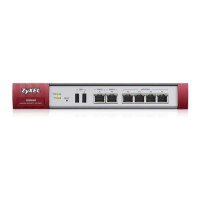160
• Outbound traffic goes from a LAN1 device to the WAN. The USG applies bandwidth
management before sending the packets out a WAN interface.
• Inbound traffic comes back from the WAN to the LAN1 device. The USG applies bandwidth
management before sending the traffic out a LAN1 interface.
You can set outbound and inbound guaranteed and maximum bandwidths for an application.
4.1.1 Bandwidth Allocation Example
Say a 10-person office has WAN1 connected to a 50 Mbps downstream and 5 Mbps upstream VDSL
line and you want to allocate bandwidth for the following:
• SIP: Up to 10 simultaneous 100 Kbps calls guaranteed
• Video conferencing: Up to 10 simultaneous 128 Kbps Skype video calls guaranteed
• Video streaming: up to 10 simultaneous 256 Kbps sessions
• HTTP: Internet access including downloading files for 10 users
• SMTP: 10 users sending email
• POP3: 10 users receiving email
• FTP: 10 users uploading and downloading files
Here is an example of allocating the any to WAN connection’s inbound and outbound packet flows.
Enable Maximize Bandwidth Usage (Max B.U.) on a packet flow to set no limit on it and let it use any
available bandwidth on the out-going interface.
Table 11 50 Mbps / 5 Mbps Connection Any to WAN Bandwidth Allocation Example
* This application does not usually generate enough traffic in this direction to require management.
4.1.2 Setting the Interface’s Bandwidth
Use the Configuration > Interface screens to set the WAN1 interface’s upstream (egress)
bandwidth to be equal to (or slightly less than) what the connected device can support. This
example uses 5120 Kbps.
4.1.3 SIP Bandwidth Management
The most effective way to ensure the quality of SIP calls is to go to the Configuration > BWM screen
and enable BWM and select Enable Highest Bandwidth Priority for SIP Traffic. See the following
section if you prefer to configure specific bandwidth management rules for SIP instead.
4.1.4 SIP Any-to-WAN and WAN-to-Any Bandwidth Management Example

